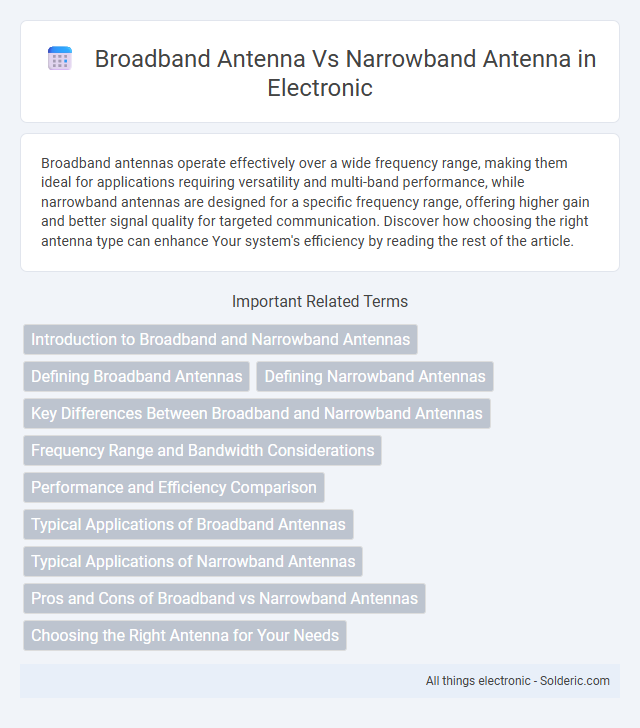Broadband antennas operate effectively over a wide frequency range, making them ideal for applications requiring versatility and multi-band performance, while narrowband antennas are designed for a specific frequency range, offering higher gain and better signal quality for targeted communication. Discover how choosing the right antenna type can enhance Your system's efficiency by reading the rest of the article.
Comparison Table
| Feature | Broadband Antenna | Narrowband Antenna |
|---|---|---|
| Frequency Range | Wide frequency range (e.g., 1 GHz to 6 GHz) | Narrow frequency range (e.g., 2.4 GHz +- 50 MHz) |
| Bandwidth | High bandwidth, supports multiple signals | Low bandwidth, optimized for single frequency |
| Design Complexity | Complex design for broadband matching | Simple, optimized for specific frequency |
| Gain | Moderate gain across frequencies | High gain at specific frequency |
| Use Cases | Wideband communication, radar, spectrum monitoring | Point-to-point links, narrowband communication |
| Cost | Generally higher due to design complexity | Lower, simpler components |
| Size | Larger due to broadband elements | Compact, frequency-specific design |
| Radiation Pattern | Stable over wide frequency range | Highly optimized for single frequency |
Introduction to Broadband and Narrowband Antennas
Broadband antennas operate over a wide range of frequencies, enabling communication across multiple bands without the need for tuning, which enhances versatility in applications such as radar, wireless networks, and satellite systems. Narrowband antennas are designed to operate efficiently within a limited frequency range, providing high gain and improved signal quality for specific communication channels like ham radios or GPS systems. The choice between broadband and narrowband antennas depends on factors such as frequency coverage requirements, application type, and desired performance characteristics.
Defining Broadband Antennas
Broadband antennas are designed to operate efficiently over a wide range of frequencies, enabling consistent performance across multiple frequency bands. These antennas support diverse applications such as wireless communication, radar systems, and spectrum monitoring by providing broad frequency coverage and stable impedance characteristics. In contrast, narrowband antennas are optimized for a specific frequency range, offering higher gain and better selectivity within that limited spectrum.
Defining Narrowband Antennas
Narrowband antennas are designed to operate efficiently within a limited frequency range, typically offering high gain and optimal performance for specific communication channels. These antennas exhibit a fixed resonant frequency, which enhances signal integrity and reduces noise in applications such as satellite communications and radio broadcasting. Their frequency selectivity minimizes interference, making them ideal for systems requiring stable and reliable signal transmission across a narrow bandwidth.
Key Differences Between Broadband and Narrowband Antennas
Broadband antennas operate over a wide frequency range, providing versatile performance for multiple communication bands, while narrowband antennas are designed to operate efficiently within a limited frequency range, offering higher gain and better selectivity. Broadband antennas typically feature complex designs such as log-periodic or spiral structures to maintain impedance matching across frequencies, whereas narrowband antennas often use simpler resonant elements like dipoles or patches optimized for specific frequencies. The key differences lie in frequency range, bandwidth efficiency, and application suitability, with broadband antennas favored for multi-band systems and narrowband antennas preferred for high-precision, single-frequency usage.
Frequency Range and Bandwidth Considerations
Broadband antennas offer a wide frequency range and high bandwidth, enabling them to operate efficiently across multiple frequency bands and support diverse communication systems. Narrowband antennas are designed for a specific frequency or limited range, providing optimized performance at a particular wavelength but with reduced flexibility for other frequencies. The choice between broadband and narrowband antennas depends on application requirements, balancing broad spectral coverage against focused signal gain and selectivity.
Performance and Efficiency Comparison
Broadband antennas offer a wider frequency range, enabling efficient signal transmission across multiple bands, which enhances overall performance in dynamic environments. Narrowband antennas provide higher gain and better selectivity within a limited frequency range, resulting in improved efficiency for targeted applications. The choice between broadband and narrowband antennas depends on the specific requirements for frequency coverage, gain, and signal clarity in the intended use case.
Typical Applications of Broadband Antennas
Broadband antennas are extensively used in applications requiring wide frequency coverage such as wireless communication systems, radar, and spectrum monitoring. Their ability to operate efficiently over a large frequency range makes them ideal for military and commercial sectors including satellite communication and signal intelligence. Broadband antennas also support multi-band devices, reducing the need for multiple antennas in devices like smartphones, Wi-Fi routers, and IoT sensors.
Typical Applications of Narrowband Antennas
Narrowband antennas are predominantly used in applications requiring high-frequency stability and precise signal reception, such as radar systems, satellite communications, and specific military telemetry. These antennas excel in environments demanding minimal frequency drift and enhanced signal-to-noise ratios, facilitating reliable data transmission over fixed frequency bands. Typical applications include GPS receivers, point-to-point microwave links, and specialized radio frequency identification (RFID) systems.
Pros and Cons of Broadband vs Narrowband Antennas
Broadband antennas offer a wide frequency range, allowing versatile applications and improved signal consistency, but may suffer from lower gain and increased noise compared to narrowband antennas. Narrowband antennas provide higher gain and better selectivity within a specific frequency, making them ideal for targeted communication, yet their limited bandwidth restricts flexibility and multi-frequency use. Choosing between broadband and narrowband antennas depends on the balance between frequency range requirements and performance characteristics such as gain, noise, and application specificity.
Choosing the Right Antenna for Your Needs
Broadband antennas cover a wide frequency range, making them ideal for applications requiring versatility and multi-frequency operation, while narrowband antennas are optimized for a specific frequency, offering higher gain and better signal quality within that range. Your choice depends on the frequency requirements and performance priorities of your communication system. Selecting the right antenna ensures optimal signal reception, transmission efficiency, and overall reliability.
broadband antenna vs narrowband antenna Infographic

 solderic.com
solderic.com